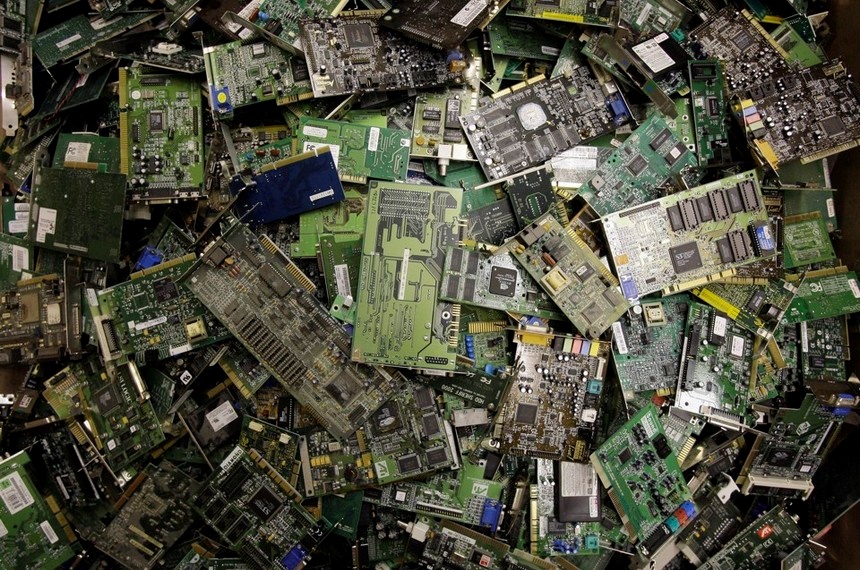
E-waste: the fastest-growing waste stream in the EU
Waste of electrical and electronic equipment (WEEE) such as household appliances, computers, television sets and mobile phones is one the fastest-growing waste streams worldwide: the 2012 UN report projected that by 2017 global e-waste will increase a further one third from 49.7 million to 65.4 million tons annually. The increase in total amount of e-waste produced is due to multiple factors, such as rapid technology changes, lowering of initial costs, consumer demand, built-in obsolescence and short lifespan of products.
E-waste is considered to be one of the fastest growing waste streams in the EU, with some 9 million tonnes generated in 2005 and expected to grow to more than 12 million tonnes by 2020. Almost half of e-waste in the EU consists of large household appliances (fridges, washing machines), while IT and telecommunications equipment (computers, phones) and consumer equipment (TV- sets, hi-fi) each account for about 20%.
E-waste presents a particularly complex waste flow in terms of variety of products, mixture of different materials and components, contents in hazardous substances and growth pattern. Hazardous substances found in e-waste, such as mercury, lead, cadmium and flame retardants like polybrominated biphenyls (PBB) or polybrominated diphenyl ethers (PBDE), if not properly managed, can cause major environmental and health problems. E-waste also contains precious metals such as gold, copper and nickel and rare materials of strategic value such as indium and palladium, which can be recovered, recycled and used as valuable source of secondary raw materials.
To address these problems within the EU, the first WEEE Directive (Directive 2002/96/EC), which came into force in 2003, provided for the creation of collection schemes where consumers return their e-waste for free. In order to tackle the rapidly increasing e-waste rates, the new WEEE Directive (Directive 2012/19/EU) has been put in place in 2012. The Directive aims to prevent or reduce the negative environmental effects resulting from the generation and management of e-waste and from resource use. Its key purpose is to contribute to sustainable production and consumption by prioritising the prevention of e-waste and then the re-use, recycling and other forms of recovery, therefore incorporating the waste hierarchy established in The Waste Framework Directive (Directive 2008/98/EC).
In the new Directive, the collection targets for Member States changed from a flat rate of 4 kg per inhabitant per year to a variable, percentage-based approach related to products placed on the market (POM): from 2016 onwards, the collection target consists of 45% of the average weight of products placed on the market in a given country in the 3 preceding years, while from 2019 the collection target increases to 65% of the average weight of products placed on the market in a given country in the 3 preceding years.
Special responsibilities were also placed on producers, summed up under the so called Producer Responsibility Principle which states that manufacturers and importers of products bear a degree of responsibility for the environmental impacts of their products throughout the products’ life-cycles” meaning that they accept their responsibility when they design their products to minimize the life-cycle environmental impacts as well as responsibility for the environmental impacts that cannot be eliminated by design. The Directive has put the principle in concrete terms and allocated responsibility to producers involved in the lifecycle of electric and electronic products, meaning that the producers had to make a financial contributions to cover the costs of collecting, treating and sustainably disposing of waste from both household and non-household equipment deposited at dedicated collection but also make changes in design and production methods which take into account the end-of-life cycle.
Sources:
http://ec.europa.eu/eurostat/web/waste/key-waste-streams/weee
http://eur-lex.europa.eu/legal-content/EN/TXT/?uri=CELEX:32002L0096
http://eur-lex.europa.eu/legal-content/EN/TXT/?uri=CELEX:32012L0019
http://eur-lex.europa.eu/legal-content/EN/TXT/?uri=CELEX:32008L0098
http://ec.europa.eu/environment/waste/weee/pdf/final_rep_okopol.pdf
Author: Ivan Petarčić (RRiF-plus d.o.o.)

Follow us on